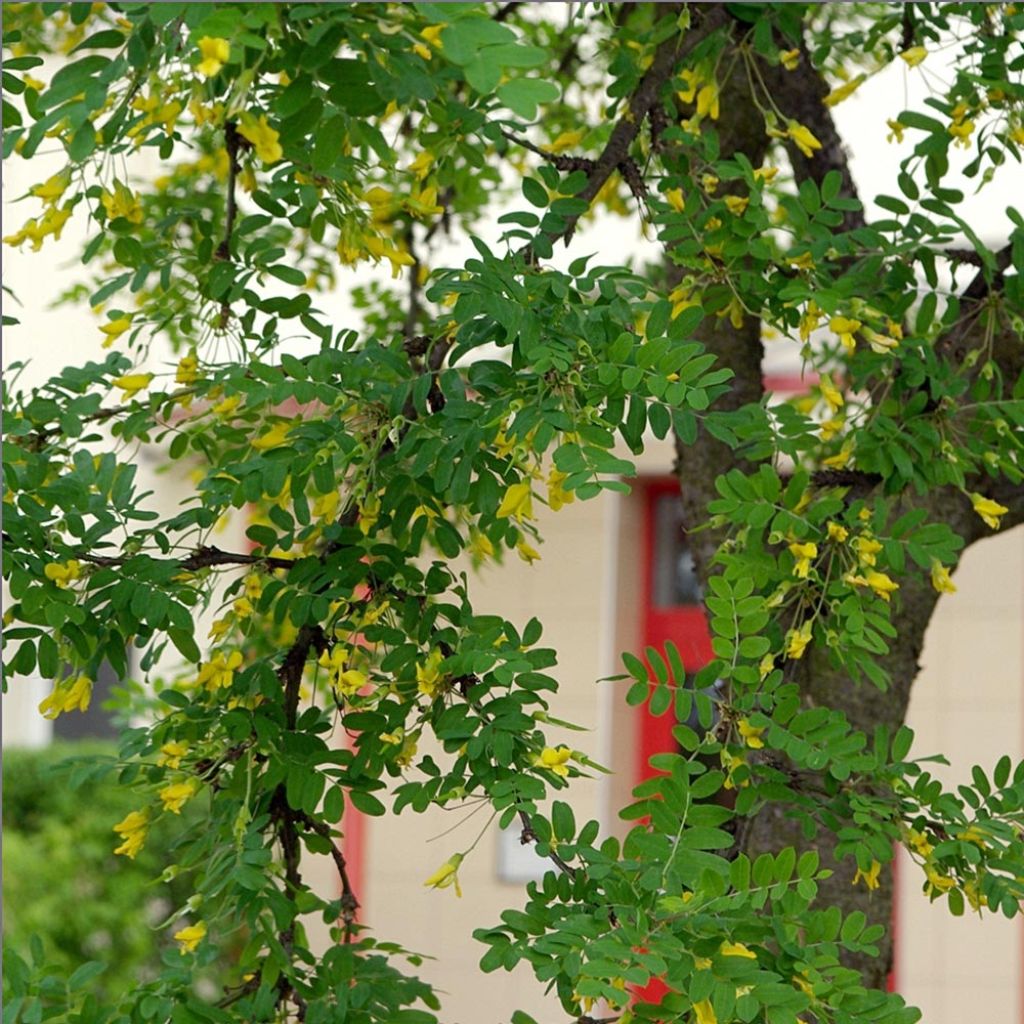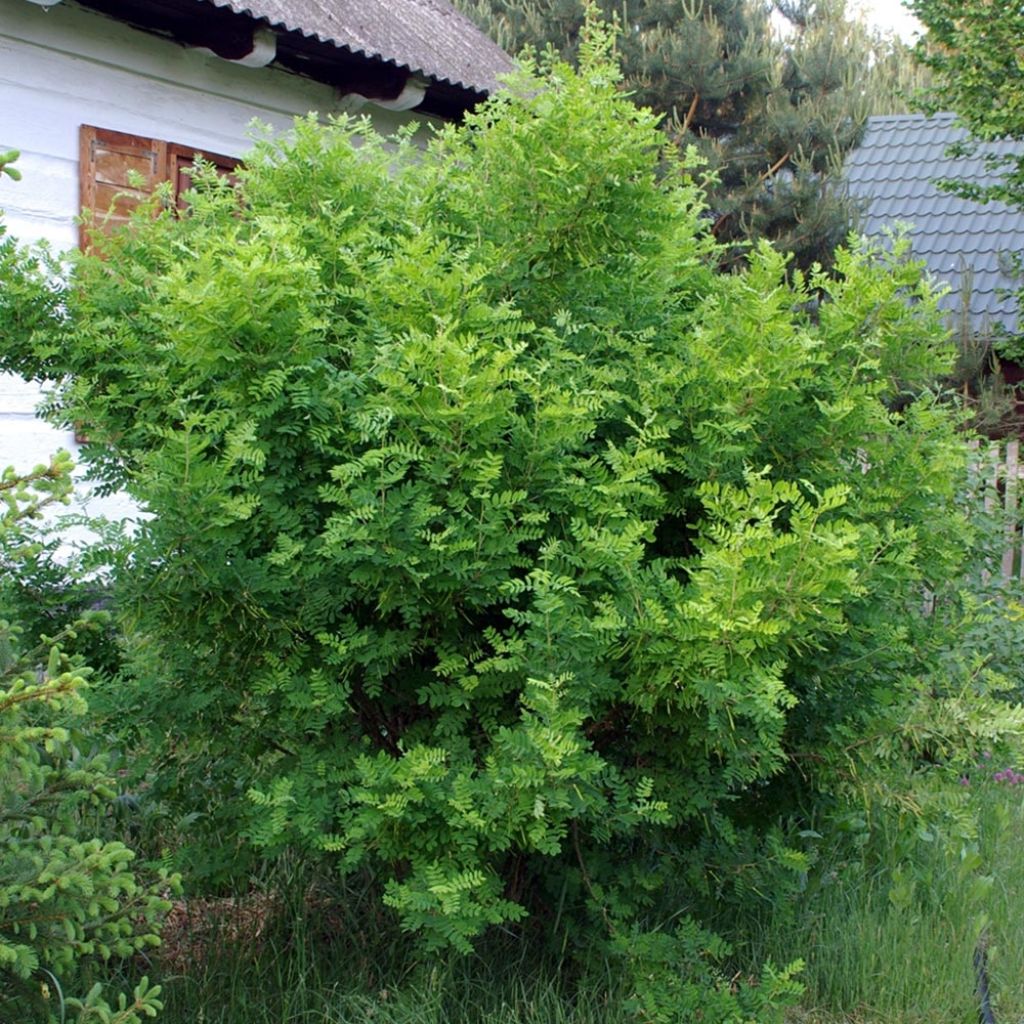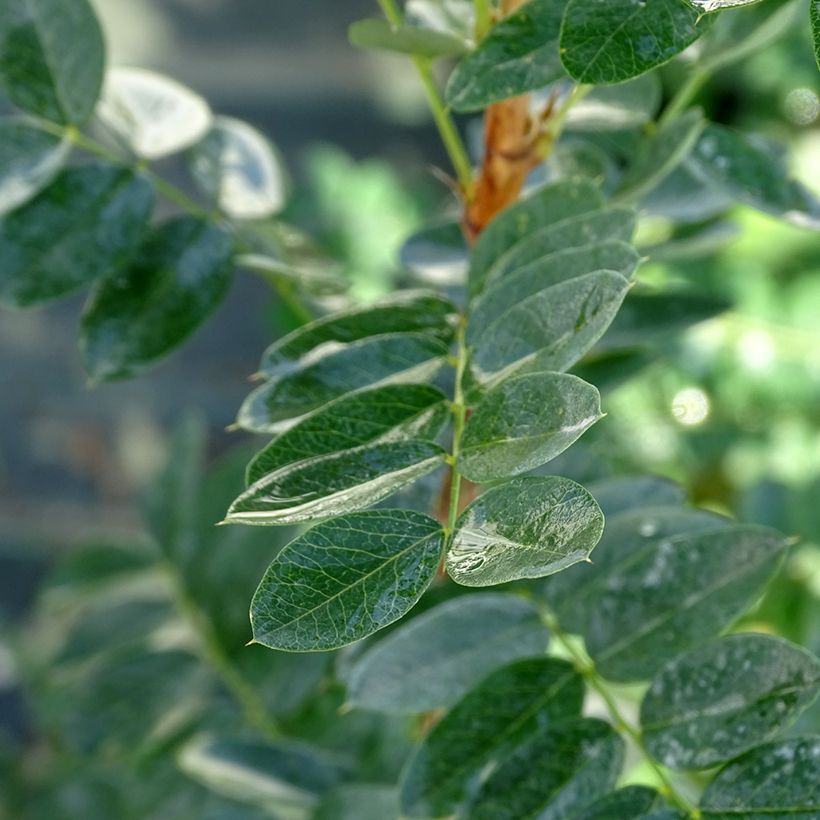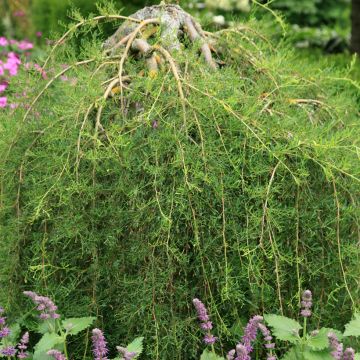

Caragana arborescens


Caragana arborescens


Caragana arborescens


Caragana arborescens
Caragana arborescens
Caragana arborescens
Siberian pea tree, Siberian pea shrub
The Siberian Pea Shrubs have arrived very beautiful, the recovery seems to be going well. The plant is a nitrogen fixer and helps enrich the soil... it withstands harsh weather conditions very well... to be continued.
Olivier, 29/10/2024
This plant carries a 24 months recovery warranty
More information
We guarantee the quality of our plants for a full growing cycle, and will replace at our expense any plant that fails to recover under normal climatic and planting conditions.
From 5,90 € for pickup delivery and 6,90 € for home delivery
Express home delivery from 8,90 €.
From 5,90 € for pickup delivery and 6,90 € for home delivery
Express home delivery from 8,90 €.

Would this plant suit my garden?
Set up your Plantfit profile →
Description
Caragana arborescens is also known as the Yellow Acacia due to the appearance of its foliage and yellow flowering, modestly reminiscent of acacias. It is also called the Siberian pea tree, in reference to its Mongolian origins. It is difficult to find a more robust and frugal bush that can withstand harsh conditions, although it may not be the most spectacular. Thriving in a cottage-style flower bed, alongside lilacs and romantic roses, it is a valuable ally for those who garden in barren or limestone-rich soils, surrounded by vitex, Afghan sage, coronillas, and other low-maintenance plants.
Caragana arborescens belongs to the Fabaceae family, and is native to Siberia and Mongolia, where it is often planted as a hedge to protect orchards from wind and unwanted visitors. Hardy well beyond -20°C (-4 °F), this plant tolerates a wide range of soils, from slightly acidic to very calcareous, even poor ones, but it dislikes waterlogged soils. Its deep root system allows it to withstand drought once the bush is well established.
It is a fast-growing deciduous bush, composed of multiple stems, but it can also form a small tree with low branches. Often wider than it is tall, it reaches an average size of 4.5 to 5m (15 to 17ft) in all directions. It has a naturally flexible and rounded habit, supported by thin slightly trailing branches. Its dense and fresh light green foliage is made up of leaves divided into 5 to 7 pairs of small ovate and villous leaflets, about 2cm (1in) long, with small spines. They turn yellow in autumn before falling. The flowering takes place from April to May. Short clusters of light-yellow pea-like flowers open here and there among the foliage, on the previous year's wood. This honey-scented flowering is followed by the formation of 5cm (2in) long pods, each containing 4 to 6 seeds. The young pods, peas, and flowers are edible.
Caragana arborescens is not a spectacular plant nor does it have an exotic appearance, but it can adapt to difficult conditions, including very severe frost. It is valuable for gardens where the soil lacks depth, and for soils degraded by construction work in a brand-new garden. It can be planted in an informal hedge, alongside Coronilla glauca, cotinus, Lonicera tartarica, Sophora davidii, buddleias, Phillyrea angustifolia, or even Rhamnus alaternus 'Argenteovariegata' (in not too cold climates). All these low-maintenance shrubs are perfect for adding a touch of whimsy to neglected areas of the garden. For example, you can plant small shrubs like cistus, lavender, helianthemums, or bushy sage with summer flowering (Salvia 'Royal Bumble', S. 'Rêve Rouge', S. 'Raspberry Royal') next to it, in a sunny spot.
Report an error about the product description
Caragana arborescens in pictures


Plant habit
Flowering
Foliage
Botanical data
Caragana
arborescens
Fabaceae
Siberian pea tree, Siberian pea shrub
Central Asia
Other Caragana - Siberian Pea Tree
Planting and care
Plant Caragana arborescens in spring in cool to cold regions, in autumn in warm and dry regions. Choose a very sunny exposure. Plant it in well-prepared soil, deeply loosened. It is not demanding in terms of soil, but it fears waterlogged and/or excessively acidic soils. If your soil tends to be heavy and clayey, dig a 60cm (24in) hole and fill with a mixture of garden soil, coarse sand or gravel, and leaf compost. This bush tolerates limestone in the soil very well and is satisfied with rainwater, in all regions, once it is well established. Monitor watering for the first two summers, especially in warm and dry regions. Watering should be plentiful but spaced out. It can withstand strong frosts below -15°C (5 °F) even when young. Avoid moving it, as transplanting is often difficult due to their deep root system.
This bush has few enemies in open ground, except for overly wet soils that can harm its roots. Soil that is too fertile, as is often the case with legumes, will promote foliage development at the expense of flowering.
Multiplication: by sowing primarily in autumn, as propagation by cuttings is very difficult. The seeds should be treated with hot water before sowing: pour boiling water over the seeds, then let them soak overnight. Another technique is to scarify them (rub them between two sheets of sandpaper to attack their very hard seed coat) before immersing them in hot water.
Planting period
Intended location
Care
-
, onOrder confirmed
Reply from on Promesse de fleurs
Haven't found what you were looking for?
Hardiness is the lowest winter temperature a plant can endure without suffering serious damage or even dying. However, hardiness is affected by location (a sheltered area, such as a patio), protection (winter cover) and soil type (hardiness is improved by well-drained soil).

Photo Sharing Terms & Conditions
In order to encourage gardeners to interact and share their experiences, Promesse de fleurs offers various media enabling content to be uploaded onto its Site - in particular via the ‘Photo sharing’ module.
The User agrees to refrain from:
- Posting any content that is illegal, prejudicial, insulting, racist, inciteful to hatred, revisionist, contrary to public decency, that infringes on privacy or on the privacy rights of third parties, in particular the publicity rights of persons and goods, intellectual property rights, or the right to privacy.
- Submitting content on behalf of a third party;
- Impersonate the identity of a third party and/or publish any personal information about a third party;
In general, the User undertakes to refrain from any unethical behaviour.
All Content (in particular text, comments, files, images, photos, videos, creative works, etc.), which may be subject to property or intellectual property rights, image or other private rights, shall remain the property of the User, subject to the limited rights granted by the terms of the licence granted by Promesse de fleurs as stated below. Users are at liberty to publish or not to publish such Content on the Site, notably via the ‘Photo Sharing’ facility, and accept that this Content shall be made public and freely accessible, notably on the Internet.
Users further acknowledge, undertake to have ,and guarantee that they hold all necessary rights and permissions to publish such material on the Site, in particular with regard to the legislation in force pertaining to any privacy, property, intellectual property, image, or contractual rights, or rights of any other nature. By publishing such Content on the Site, Users acknowledge accepting full liability as publishers of the Content within the meaning of the law, and grant Promesse de fleurs, free of charge, an inclusive, worldwide licence for the said Content for the entire duration of its publication, including all reproduction, representation, up/downloading, displaying, performing, transmission, and storage rights.
Users also grant permission for their name to be linked to the Content and accept that this link may not always be made available.
By engaging in posting material, Users consent to their Content becoming automatically accessible on the Internet, in particular on other sites and/or blogs and/or web pages of the Promesse de fleurs site, including in particular social pages and the Promesse de fleurs catalogue.
Users may secure the removal of entrusted content free of charge by issuing a simple request via our contact form.
The flowering period indicated on our website applies to countries and regions located in USDA zone 8 (France, the United Kingdom, Ireland, the Netherlands, etc.)
It will vary according to where you live:
- In zones 9 to 10 (Italy, Spain, Greece, etc.), flowering will occur about 2 to 4 weeks earlier.
- In zones 6 to 7 (Germany, Poland, Slovenia, and lower mountainous regions), flowering will be delayed by 2 to 3 weeks.
- In zone 5 (Central Europe, Scandinavia), blooming will be delayed by 3 to 5 weeks.
In temperate climates, pruning of spring-flowering shrubs (forsythia, spireas, etc.) should be done just after flowering.
Pruning of summer-flowering shrubs (Indian Lilac, Perovskia, etc.) can be done in winter or spring.
In cold regions as well as with frost-sensitive plants, avoid pruning too early when severe frosts may still occur.
The planting period indicated on our website applies to countries and regions located in USDA zone 8 (France, United Kingdom, Ireland, Netherlands).
It will vary according to where you live:
- In Mediterranean zones (Marseille, Madrid, Milan, etc.), autumn and winter are the best planting periods.
- In continental zones (Strasbourg, Munich, Vienna, etc.), delay planting by 2 to 3 weeks in spring and bring it forward by 2 to 4 weeks in autumn.
- In mountainous regions (the Alps, Pyrenees, Carpathians, etc.), it is best to plant in late spring (May-June) or late summer (August-September).
The harvesting period indicated on our website applies to countries and regions in USDA zone 8 (France, England, Ireland, the Netherlands).
In colder areas (Scandinavia, Poland, Austria...) fruit and vegetable harvests are likely to be delayed by 3-4 weeks.
In warmer areas (Italy, Spain, Greece, etc.), harvesting will probably take place earlier, depending on weather conditions.
The sowing periods indicated on our website apply to countries and regions within USDA Zone 8 (France, UK, Ireland, Netherlands).
In colder areas (Scandinavia, Poland, Austria...), delay any outdoor sowing by 3-4 weeks, or sow under glass.
In warmer climes (Italy, Spain, Greece, etc.), bring outdoor sowing forward by a few weeks.

































